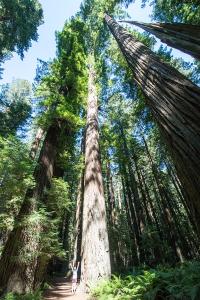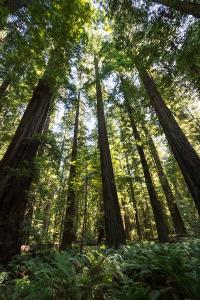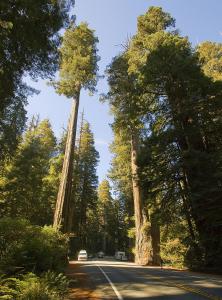 A few springs ago, my wife and I drove up the California coast, heading for Oregon and its iconic coastal beauty. We were not at all disappointed by the stunning sights we saw there in Oregon, but I admit that I was more taken with the drive we made through the Redwood National Park up Highway 101. It is a most unusual National Park, since it primarily consists of a single road through enormous redwood trees, on both sides of the highway, representing a huge stand of these giants, the largest concentration of the unique living things on earth.
A few springs ago, my wife and I drove up the California coast, heading for Oregon and its iconic coastal beauty. We were not at all disappointed by the stunning sights we saw there in Oregon, but I admit that I was more taken with the drive we made through the Redwood National Park up Highway 101. It is a most unusual National Park, since it primarily consists of a single road through enormous redwood trees, on both sides of the highway, representing a huge stand of these giants, the largest concentration of the unique living things on earth.
When earth’s climate was wetter than it has since become, redwood groves were far more common. In fact, as little as five million years ago, a mere blip in earth’s geologic time, redwoods dotted the landscape of Europe from England to Russia. The last ice age apparently did them in, even though they are among the very hardiest of trees. They are nearly immune to insect infestation, various sorts of mammal attacks (bears are said to eat the inner bark of redwoods when they have the chance), and fire is in the long run very good for them, since it destroys their less hardy competitors, opening the way for more seedlings to flourish. In fact, the more powerful the fire, the better it can be for the redwood. This year, California has been cursed with dreadful fires, covering more acres than it any time in the past, especially in the more heavily forested north of the state. One can only imagine how the redwoods may benefit from this widespread devastation.
Just why am I so taken with these monumental trees? The oldest one in the National Park has been on earth and living for at least 2200 years. Its height is over 375 feet, its circumference some 30 feet. Reports of trees even older continue to appear, but there is no evidence of an older redwood extant. Still, what that means is that this tree, along with several of its siblings, were living on the California coast when the Seleucid king Antiochus Epiphanes IV was expelled from Jerusalem by the Maccabees in the middle of the second century BCE! When Jesus walked the earth, these trees were already about 200 years old. It is simply hard to imagine what this tree has witnessed in its over two millennia of life.
It is unfortunately true that unlimited logging of these stunning trees was allowed in the 1850’s, well before anyone had begun serious study of them. All that the loggers saw was vast quantities of board feet, leading to buckets of cash. Exactly how many were cut down and stripped will never be known, but the countless redwood decks that have been built since are testimony to the redwood’s aesthetic appeal and durability. Little wonder that tree cutters look longingly at them, and not only for their beauty.
For the past 15 months I have lived on Redwood Ave. in Culver City, CA. Directly in front of the main house on our property stands a huge redwood, not the Sequoia redwood that makes up the California national park, but surely a cousin. Its bark is a decided red, its pinecones large and filled with seeds, its needles long, green, and lush year round. Two other like trees are to be found on our street, no doubt the source of the street’s name. Ours, I think, is the tallest, standing about 75 feet in its glorious splendor.
Our two grandchildren love nothing better than collecting the tree’s numerous cones, and filling a basket with them that adorns a table in their living room. It is something of a contest between the two of them to find the best cone to add to the collection. So, here are other reasons of a more personal kind why I love these trees.
I love the redwood I see each day, but it hardly bears comparison with the 100 miles of its grander cousins in northern California and southern Oregon. To travel highway 101 through the groves, shaded by the giant canopies on both sides, is to experience something that one can find no where else on earth. These trees love the foggy mist that regularly floats in from the Pacific Ocean. The denser the mist, the taller the trees, and the hardier they grow. To stand in their shade is to feel smaller and yet somehow more protected. To experience their dense and ancient canopy is to be reminded that our time here is brief, merely a tiny dot on the ocean of time. Whenever anyone begins to feel somehow superior, somehow grander than one ought to feel, some time with the redwoods may be just the thing to context one’s human life in the arc of eternity.
The redwoods have often in recent years become symbols of environmental degradation. Again and again, activists have hoisted themselves high into the redwoods to prevent the giants from the logger’s ax, and to announce that our humanity is finally enhanced by their existence among us. We need these redwoods far more than they need us, for they were here long before our distant ancestors dropped from the much smaller trees onto the African landscape, barely a million years ago. If the redwoods were to disappear, their loss would be incalculable, and our human disappearance might then be not far behind.
If you ever have the chance to see, to breathe in these magnificent living things, I urge you to do so. They are surely among earth’s greatest treasures, a giant sign of earth’s fantastic fecundity, a living witness to the act of creation that is ongoing, a wonderful symbol of God’s deep care for all things.
(Images from Wikimedia Commons)











